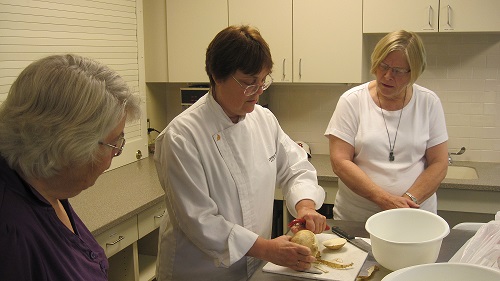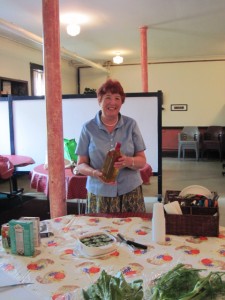Have you ever tried a dessert made of quinoa? Or, eaten cactus fruit? Older adults participating in the Seniors on the Move program through the Montachusett Opportunity Council (MOC) program have done both. They’ve also learned a lot more about how to make small changes that have big impact on their overall health.
Seniors on the Move is an evidence-based program focused on nutrition and exercise to reduce symptoms of chronic illness. The program focuses primarily on seniors with diabetes and heart disease but also includes older adult men and women with a variety of other illnesses from arthritis and renal disease to cancer and Alzheimer’s. Participants range in age from 60 to the oldest participant so far, who was 98.
The curriculum takes place over eight weeks, either on a weekly or monthly schedule. Participants learn about basic nutrition as well as increasing fruits and vegetables, adding fiber and reducing fat in their diets. They also learn tips for creating a healthy breakfast, a better lunch and a super supper, and, most importantly, try out new recipes in the class.
“Each participant has a job at every class, whether it’s chopping vegetables, washing dishes or setting the table,” said Nancy Fillers, RD, LDN, a dietician with MOC and the program’s instructor. “We tailor recipes for our participants’ various health needs and structure the Q&A portion of our class accordingly. For example, we use only natural sweeteners like honey and agave in our recipes, and we use less of them than traditional sugar intake. We also teach our students how to incorporate the fruits and vegetables that are in their fridge into anything they’re cooking – from roasting apples as a side dish to adding veggies to meatloaf or morning eggs.”
The program is so successful that, according to Fillers, one woman even said “I feel like I’m denying myself now if I don’t have a fruit or vegetable with every meal.”
Fillers also explained how she teaches participants to limit their fat and sodium, particularly for those with heart disease. Students learn about healthy fats and how to cook with olive oil and fresh herbs, instead of saturated fats or salt.
“The interaction and hands-on nature of the class is paramount to our success,” added Ayn Yeagle, nutrition manager at MOC. “Program participants are much more likely to remember something and make it a habit the more they do it themselves.”
At the end of the program, Fillers takes the class on a virtual shopping tour and teaches them how to get the best nutritional value for their dollar including how to read labels and steer clear of product marketing ploys like “new and improved.”
Exercise is also a critical component of each class. Fillers uses stretch bands and squeeze balls to teach activities and stretches that the older adult participants can incorporate into their daily lives.
“I ask them to make one small change per week and it’s amazing what a difference these changes make,” said Fillers who provided a range of examples from drinking an extra glass of water each day
to taking the stairs instead of the elevator to eliminating the salt shaker from the table, or even brushing teeth more frequently. “One participant decided to smile at three strangers each day. That simple act made her feel good. And, when you feel good, you’re ultimately healthier,” added Fillers.
Fillers also teaches participants that they don’t have to do 20 minutes of exercise all at once. “They just need to be cognizant of physical activity,” said Fillers. “I tell my students to use the stretch bands if they’re watching TV. Just do a different exercise during each commercial break.”
“We had one gentleman in our class who had had a debilitating stroke. Just walking around the house was difficult for him,” added Yeagle. “Now, he and his wife purposefully go to the grocery store and he pushes the cart. He also commits to getting the mail each day so that he benefits from both exercise and fresh air.”
“This program really impacts older adults’ lives,” said Fillers. “One participant in the Leominster Seniors On the Move program thanked me for teaching her how to cook again.” This participant is recovering from throat cancer and was living on a diet of prepared soft foods. She decided to attend the program because it focused on cooking for chronic illnesses and she was tired of a steady diet of prepackaged foods.

Seniors on the Move participants try jicama for the first time
“The program changed my life,” the participant said. “I was afraid I could not cook healthy food for myself but the instructor showed me that I could prepare and eat most of the foods in the Seniors on the Move program and that I could adapt my recipes so that they would be a softer texture. I have made several of the recipes from class many times over and I feel so much better eating foods that include fruits and vegetables.”
Also a positive outcome of the Leominster Seniors on the Move program, eight participants of the 12 who enrolled in the program reported they will continue cooking healthy meals together in the community kitchen. The group stated they will research meals that follow the guidelines taught via the program (low in fat and sodium, high in fiber, fruits and vegetables) and recreate recipes prepared in class.
Since the Seniors on the Move program launched in 2008, it has reached 221 older adults with 75 percent attending all eight sessions. Seventy-five percent of these participants have lost an average of 2.7 pounds, 59 percent have lost three pounds or more and 66 percent have lowered their blood pressure. Even better, 100 percent of participants have demonstrated improved healthy behaviors.
This story was published originally in the Tufts Health Plan Foundation’s May 1, 2013 newsletter and updated in November 2013.


